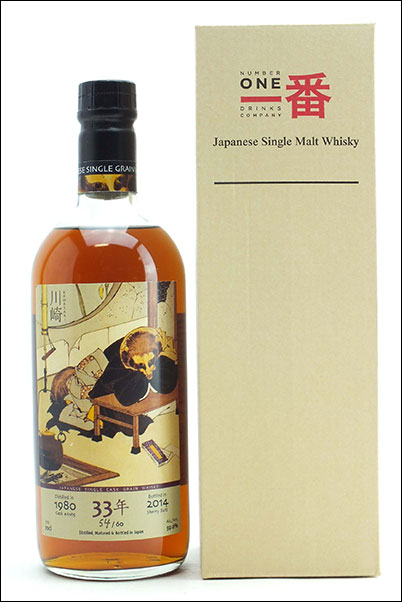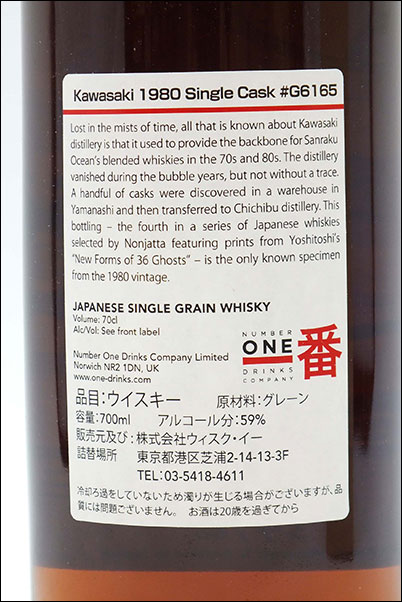Thursday 9th October 2014
Karuizawa 1981 Cask #6056
If there is a hot commodity for any whisky collector or investor during 2014 then it can be summed up in one word; Japanese. Some commentators may go further and suggest the Karuizawa distillery specifically, which is certainly the leading light currently in the market. However here at Just Whisky we believe that other Japanese distilleries such as Hanyu, Kawasaki (also both closed) are just as worthy of the limelight and your interest.
In our October auction we will have lots from all 3 distilleries and in this blog we’ll be taking a little more time to talk about what makes these specific releases of interest and very collectable. We’ve already discussed the mystery that is Kawasaki distillery in an earlier piece. It’s too easy just to list a lot and put up the bottle details and packaging information; we like to show a little more dedication hence this blog.
Right, Karuizawa. This distillery is sadly no more and with most things in life you don’t truly appreciate something till it’s no longer around. This is particularly so with this distillery that didn’t enjoy the worldwide reputation it has today during its existence. If it had then it’s very likely Karuizawa would still be producing its distinctive whisky today.
Set at the foot of Mount Asama, the Nagano region is more famous for wine rather than whisky. Karuizawa was originally a vineyard before the then owners (Daikoku-Budoshu) decided that a whisky distillery would be the next logical step in 1955. This was an era of increased domestic demand in Japan for whisky. Regulations were being relaxed and the hard-working public were developing a taste for whisky, as mentioned in our Kawasaki article.
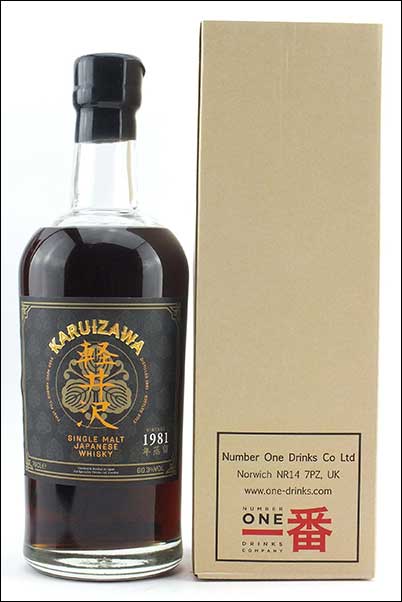
Now Mount Asama is an active volcano, so setting a distillery on its doorstep might not be the greatest or safest decision. However there was logic within the madness as the climate is comparable to Scotland and would deliver an ideal level of consistent maturation. Over the years the ownership of the distillery chopped and changed never allowing for a period of stability or identity to develop. The distillery was mothballed in 2001 and never reopened.
Karuizawa throughout its existence only exclusively used the Golden Promise strain of barley that has long been dispensed by most Scottish distilleries as being inefficient. It does however add character to the whisky which is sadly missed in today’s climate of computerised and ultra-efficient whisky production. The combination of an older strain of barley, slow maturation (4 of the 5 onsite warehouses were traditional dunnage) and reliance on quality sherry casks meant at older ages Karuizawa can deliver spectacular results, which is why it is only now being appreciated.
This is partially due to the sterling work of Number One Drinks who had the foresight to negotiate an exclusive deal for the remaining casks at the distillery from the last owners. Over the years they have become the only bottler of Karuizawa often putting together distinctive releases with charismatic labels. Stocks are dwindling and while Number One have never commented on what remains, it is clear that sooner rather than later Karuizawa casks will be no more. If you have an interest in finding out more about Karuizawa then we’d suggest you read The Whisky Exchange blog that had a detailed 9 part series on the distillery and those remaining casks.
This takes us nicely onto this specific bottle, as The Whisky Exchange (TWE) today are the main source of releases of Karuizawa. In 2013 they revealed that they were releasing a single sherry cask of Karuizawa from 1981 that was the best one that they have bottled, which is stating something given the bottles they’ve experienced from this distillery.
This Karuizawa is from cask number 6056 and was a first fill sherry cask bottled at 60.3% strength. The edition number was never revealed although TWE confirmed they had just 240 of these to sell and as far as we’re aware that seems to be almost the complete edition. The cask has given this whisky an incredible jet black colour that is truly distinctive and sums up the unique approach of Karuizawa. If you could own just 1 example of a sherry cask Karuizawa then this is arguably the one to possess. We’re very pleased to be bringing you this opportunity to bid on what is a classic Karuizawa.
Sunday 5th October 2014
Hanyu 2000/2014 Grappa Finish Ghost Series
A wonderful extension of the Japanese Nonjatta whisky website is the release of special editions as and when suitable casks are discovered. These form part of their ongoing ‘Ghost series’ based on a series of prints from Tsukioka Yoshitoshi’s epic series of woodblock prints.
We’ve already featured one of these releases in an earlier entry in the form of an extremely rare Kawasaki. To date there have only been 5 releases in the ‘Ghost series’ spread across 3 closed Japanese distilleries in the form of Hanyu, Karuizawa and Kawasaki. Japanese whiskies from closed distilleries are currently immensely popular amongst collectors and investors. The ‘Ghost series’ is arguably the most collectable due to its very limited numbers, unique casks, distinctive labelling, focus on quality and also only being released in Japan.
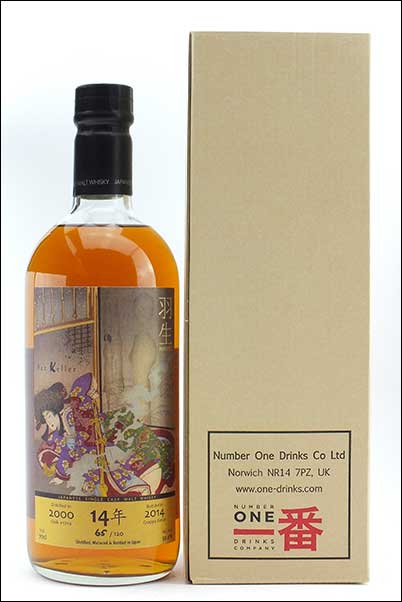
This very special Hanyu was discovered in a Japanese whisky bar called Bar Keller and available to purchase by the dram. The roots of this unusually finished Hanyu go back to a 1990 vintage Paolo Berta grappa. Left with an empty cask, the owner contacted none other than Ichiro Akuto to enquiry whether the cask would provide a suitable secondary maturation for one of his whiskies. What they selected for this experiment was a Hanyu from 2000, which was the last year of production at the distillery before being dismantled in 2004. The grappa cask was then left to mature at Chichibu distillery.
Fast forward to the opening of Bar Keller and the design incorporating 2 casks mounted within the bar wall; one of their choices was the whisky maturing in the aforementioned grappa cask. Such was its quality that the team behind Nonjatta set about releasing an edition of just 120 bottles. We would encourage you to read in more detail about the series and the whiskies themselves at the Nonjatta website.
We’re often asked about Japanese whiskies here at Just Whisky Auctions. Karuizawa is receiving most of the limelight and sightings of bottles of Kawasaki are in comparison even rarer. It is possible that there is no more Kawasaki waiting to be bottled and the companies who own the remaining stocks of Karuizawa and Hanyu only comment generally about their remaining inventory levels.
It is Hanyu that is often overlooked at auction in favour of Karuizawa; this potentially is an oversight as stocks of Hanyu are rumoured to be nearly exhausted. Add to the fact that this is the only grappa finished Japanese whisky released to date and you have something very rather special. If we were asked which Japanese distillery will receive even more attention in the coming years, then we'd say Hanyu.
Just Whisky is extremely pleased to be bringing you this Hanyu Ghost edition, which is the first time the bottle has been seen at auction outside of the Far East as far as we're aware. If you are just building your Ghost collection or becoming interested in Japanese whiskies, then this is an opportunity that doesn’t come around very often.
Thursday 2nd October 2014
Karuizawa 1982 Bourbon cask
Releases from the Karuizawa distillery are thin on the ground and thus are extremely collectable. Its reputation continues to grow amongst collectors, investors and enthusiasts many of whom dismissed or overlooked Japanese whisky as a whole.
Karuizawa during its existence was one of the smallest Japanese distilleries; a mere blip compared to the giants of Suntory and Nikka, both of whom continue to dominate the domestic market and have grown in popularity abroad. Only through time have we grown to appreciate Karuizawa’s style of whisky with its stubborn resistance to change. It’s reliance on the finest sherry casks, exclusively using the Golden Promise strain of barley, traditional dunnage warehouses and the location providing the perfect maturation conditions. Set in the shadow of Mount Asama this mountain provided a natural medium hard water source. All of these factors combine with the rarest and most costly resource of all; patience. Through time these key characteristics have united to produce some sensational whiskies.
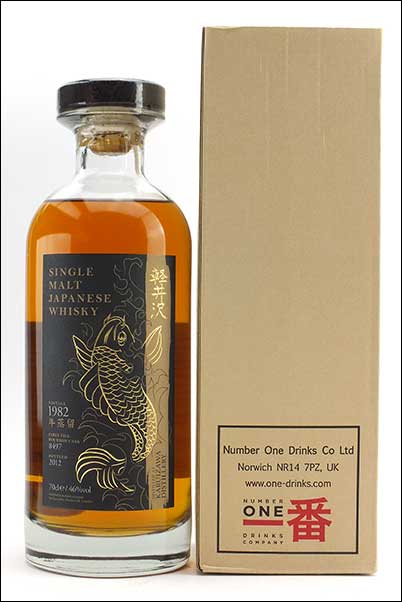
With around 90% of its production being devoted to the sherry cask, this style of whisky has become synonymous with the distillery. These sherry monsters are hugely collectable and distinctive with our October auction arguably featuring the classic example in the form of a 1981 Karuizawa. Yet what of the remaining 10% production? According to Ulf Buxrud’s excellent book ‘Japanese Whisky Facts, Figures and Taste’, this percentage consisted of bourbon, American white oak and various wine casks.
Over the years single cask bourbon releases from Karuizawa have been the oddity amongst its extremely sparse schedule of releases. The remaining cask stock was purchased by Number One Drinks who have strategically released the existing editions over the years. The majority of their releases have been single cask expressions with the exception being the Spirit of Asama range, which was a blend of various casks in a justified attempt to create a widely available Karuizawa edition that was priced to be accessible to all. Of course even the Spirit of Asama has recently sold out and is experiencing a surge in price at auction.
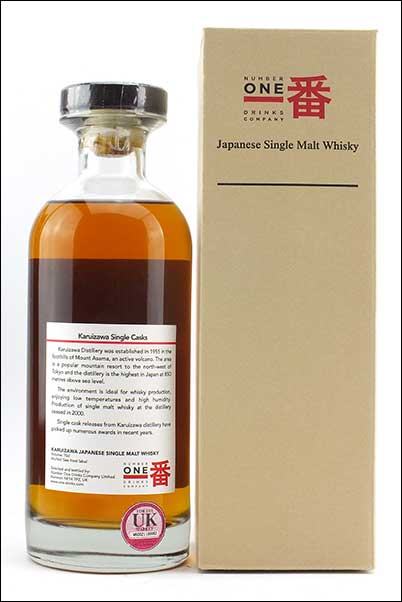
To date there have only been a handful of single cask bourbon releases from Karuizawa. These are now receiving growing attention from collectors and investors due to their relative scarcity. If you do manage to purchase a Karuizawa then the overriding odds will be that it is from a sherry cask but what about a bourbon cask?
This Karuizawa was originally distilled in 1982 before being bottled in 2012 from a first fill bourbon cask (#8497) with an alcohol strength of 46%. Adorned with a stunning Koi style label we’re pleased at Just Whisky to bring you the opportunity to own such a bottle.
Friday 12th September 2014
At Just Whisky we are fortunate to auction hundreds of bottles on a monthly basis, many of which we would never normally see. Some of the most infamous or legendary bottles are specifically designed and crafted for the growing international luxury whisky market, which often means they are rarely seen in the UK due to their scarce numbers.
Shortly after celebrating the 200th anniversary of the Royal Brackla distillery in 2012, its current owners John Dewar & Sons (Bacardi) wanted to create a suitable extravagant commemorative piece to immortalise this milestone. Stephanie McLeod, the current Master Blender, was tasked with hand selecting a whisky of suitable quality to form the liquid centrepiece of the concept.
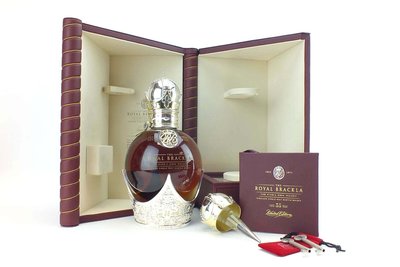
She selected a 35 year old whisky which was bottled at 49% ABV and un-chillfiltered (the way it should be) to represent Royal Brackla today. The age of the whisky is very interesting as when Bacardi bought the Dewar group from Diageo in 1998 for £1.15 billion, the deal not include any maturing whisky, meaning the new owners were effectively starting from scratch to build up a portfolio of aged stock. This specially selected whisky was finished in sherry casks to add their characteristic influences to the spirit. This served a dual purpose, not only enhancing the whisky, but also engaging the royal influence that runs strong throughout the overall presentation of this piece.
Royal Brackla is another example of a distillery that is mainly producing for blends today. As such it is rarely seen as a single malt at retail despite being the first Scotch whisky to receive the honour of a royal warrant. This was bestowed in 1833 by King William IV, who was a connoisseur of fine things including sherry; hence the finishing of this whisky in sherry casks. During this period Royal Brackla became known as ‘the drink divine’ and ‘the King’s own whisky’. The importance and influence of a royal warrant even today is recognisable but its effect in the 1830’s must have been cataclysmic. If you consider that a royal warrant has only been granted 3 times in total to a whisky distillery; this is a very rare honour. Unfortunately the King’s reign was ended prematurely by pneumonia in 1837 when he was succeeded by Queen Victoria.

The distillery is located in the Speyside region of Scotland, on the outskirts of Nairn to be more precise. Its long history shows that it has always been a valued component of blended whiskies much appreciated by blenders who have supported it since its early years; a tradition that continues today with various Dewar’s and Johnnie Walker blends. Today, Royal Brackla distillery is running at full capacity and is the largest within the Dewar group – not bad for a name that is rarely seen in whisky circles.
The Royal theme continues beyond the whisky and into the lavish presentation box featuring a crest inspired by the naval career of King William IV. A closer inspection reveals the level of detail and craftsmanship that has gone into the concept as a whole with the braided pillars that take their cue from sword grips of the period. More immediate symbols of royalty come from the crystal stopper, suggestive of a sceptre and the bottle taking the form of an orb. The most recognisable royal symbol of all being the crown shaped stand that holds the decanter.
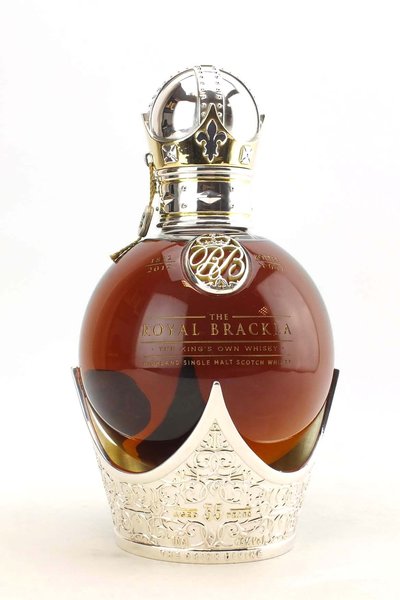
Just 100 examples of edition were released, initially debuting at Singapore Changi Airport, with a suggested retail price of $16,888, which has sold out since its release. We are very pleased to bring you this exceptional lot and the opportunity to own a very luxurious whisky with a feel of royalty.
Thursday 4th September 2014
Hopefully you enjoyed our recent guide to approaching whisky auctions and points to consider before making a bid. One area that was only briefly touched upon is what to consider collecting or investing through auctions? It’s a topic many pundits could easily devote thousands of words to given the current whisky boom.
In essence what we’re doing with this piece is focusing on a specific bottle in our upcoming September auction which is a distinctive Glen Albyn from independent bottler Signatory, who now own Edradour distillery. At the same time we can also highlight the growing popularity of the independent bottlers who have become the main source (excluding some of Diageo’s annual special releases and the odd official release) of whisky from closed distilleries. As a side note it is worth visiting Edradour as the distillery shop always stocks a great of Signatory releases. And if you take the distillery tour, then the warehouse visit will confirm the independent bottler has an impressive array of casks.
Glen Albyn distillery bottled by Signatory
Distilled 1965 | Bottled 1997
530 bottles
51.5%
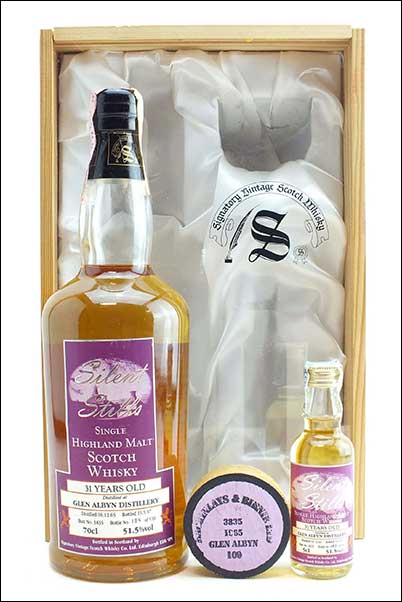
Now we say ‘closed’ but other popular terms include ‘silent’ and ‘mothballed’ to name but two. Generally, the terminology applies to distilleries that are no longer in production. The distillery may have been completely bulldozed from existence (Glen Mhor), kept in suspended animation (Glen Keith which has only recently reopened) or still stands in some form today such as Convalmore or Rosebank. It is worth highlighting that while Convalmore and Rosebank distilleries still have a physical presence, the equipment within may have been sold off, stolen or been left to the elements, to decay such as Brora.
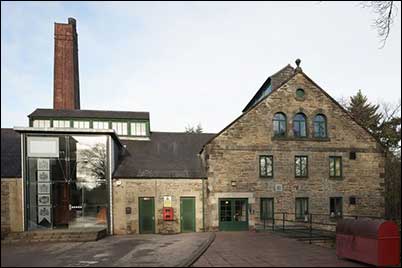
Glen Keith Distillery
Many of these distilleries closed during the early 1980’s when the whisky industry experienced a surplus in demand. Over 3 decades later and we are nearing the end of the potential lifespan for what few intact casks remain. Diageo for instance do not comment on how much they have left to bottle for Brora, Port Ellen etc. and the same veil secrecy applies to rest of the industry. Eventually we will reach a point where the only remnants of certain distilleries are in unopened bottles – it very likely that for some we’re already at this point.
This means that there is a growing interest and demand in acquiring whisky from a distillery such as Glen Albyn, which was 1 of 3 distilleries in Inverness that no longer exist today. Closed in 1983 and subsequently demolished in 1986, this Signatory release was distilled in 1965 before being bottled at 31 years old. Even in 1997, Signatory it seems appreciated the rarity of its casks by releasing the bottle with an accompanying miniature - although from the lots we’ve seen over the years these tend to be unopened anyway! At least the option exists if you wish to experience what Glen Albyn can offer without having to open up the full bottle. The final piece of the jigsaw is a decorated cask bung, which completes the edition that numbered just 530 in total.
Whisky from Glen Albyn does have a variable reputation which fits in with the 2 other Inverness distilleries; Glen Mhor and Millburn. For many collectors or investors in whisky, scores and reputations are very subjective and for completist, matter little if at all. Time is a great healer and longer than expected maturation periods can produce some very surprising whisky results. An example of this is Port Ellen as there are poor examples of this distillery for every enjoyable dram Just Whisky has experienced yet the prices continue to be robust. Even a much criticised distillery such as Littlemill has enjoyed a resurgence in interest thanks partially to some excellent recent independent releases.
So have a look through our next auction and consider some of the less fashionable and rarer distilleries. In a decade or so such lots will be become scarcer and names such as Glen Albyn, Glen Mhor, Rosebank and Brora, very much consigned to the history books.
Thursday 28th August 2014
For many enthusiasts the ultimate ambition is to own a cask of whisky and then sit back and patiently wait for the right moment to bottle its contents. This can take years, if not decades and the associated costs after purchasing a cask are prohibitive for many.
To spread such costs, clubs can be created to buy a cask and slowly save money for when the whisky is right to bottle and the VAT bill needs to be paid. Even if the cost of forming a group or joining a club proves too much, then the next best thing is to own a bottle taken from a private cask. Such releases are not widely available as many individuals did not appreciate the costs involved after the cask purchase. These casks are often sold on to brokers or direct to companies such as online retailers who possess the finances to accommodate government fees. The cask can also be sold back to the distillery that is often struggling to maintain older stock such as Bruichladdich. All these factors and many more result in private bottlings rarely coming up for sale outside of the fortunate few who owned the cask or their immediate family.
In the case of Port Sgioba a group of friends took advantage of Bruichladdich restarting production of Port Charlotte in 2001 and bought cask number 826/2001. This was part of the inaugural vintage and one of the few remaining sherry hogsheads. After 8 years the cask was bottled at a mighty 66% ABV and complimented with a label featuring an original painting by Scottish artist, Ian Gray. The overall feeling is one of quality and the Port Charlotte expression has proven to be very popular at Just Whisky Auctions. The fact that is has been well received by critics such as Charles MacLean, Dave Broom and Jim Murray just adds to the appeal.
The keen eyed will have also noticed a Caol Ila private bottling from the same group which is their 2nd release. Bottled at 12 years of age it features an original painting on the label from the same artist that depicts the stunning view from the still room at the distillery. For fans of this under-appreciated distillery it is an enticing proposition and with the cask generating only 205 bottles a very limited expression.
A quick visit to the Port Sgioba website reveals further casks, patiently maturing and waiting for the correct moment to be bottled. Hopefully we’ll be able to offer more of these unique private bottles for auction as and when the whisky reaches that perfect moment.
Tuesday 19th August 2014
A Beginners guide to collecting and investing in Whisky - Part 3
In this final part of our beginners guide trilogy, we’ve now reached the point where you’ve identified lots of interest and are looking to start bidding.
The Bid
We’re often asked about bidding tactics and generally everyone has their own approach that works best for them. Going through the previous steps one-by-one you should be aware of how the bidding format works for the auctioneer you are using. As soon as an auction opens online, some buyers may open the bidding to create a ‘hit list’ of bottles they want to watch through the auction. Mainly this is due to some sites not offering a favourites or watch list; it is a useful tool if you are wishing to keep tabs on several bottles on one handy screen. Or you may want to follow some lots as you already own the bottles to see how the market is viewing their value.
At JWA the trend is that after an initial flurry of opening bids things will slack off a little and the auction will progress at a steady pace. Once the auction deadline looms; bidding ramps up again often in spectacular fashion. My preference is to open with a bid and then see how things unfold through the course of the auction. It’s therefore important that you carefully trawl through the full auction when it opens. With lots numbering into the hundreds if not thousands this can take a while unless you want to overlook something.
You can manage what items you are bidding on or remain interested in, as the week unfolds. By the end of the week that initial cluster may have dwindled to a handful depending on the maximum bids received. Again its worthwhile being aware of how an auction closes as we specified previously – this isn’t like eBay where a brilliantly timed last second strike can snatch victory from another bidder. Generally we bid with a couple of hours to go or less. At this stage you may wish to bid up to your max remaining aware of how the bidding software accommodates maximum bids. It goes without saying to have time set aside and internet access on the closing night. You might find a different approach to bidding works better for you, which is great.
Set your limit
This goes without saying. You should in advance know roughly the market value of the bottle, the condition of the said item and queried with the auctioneer any concerns you may have. Ideally this should be done earlier in the week, as when the deadline looms auctioneers will become busier and may not be able to respond to any questions raised as quickly as they might wish or reach the seller with your query. You may want to pay a little over the odds if the lot is particularly unusual or filling an annoying void in your collection. The key is to set your limit and if the bidding goes beyond this, then you should either walk away, or take a moment to reconsider the lot as a whole.
Remember that the hammer price isn’t what you will pay. While we’ve covered charges in an earlier feature you will often have to pay postage and potentially VAT. There are variety of pricing and postage charges across the auctioneers so consider this when setting your limit and bidding.
Awareness
Often when an auction is closing we like to have time set aside to go back through the lots. This can potentially highlight a bargain or something you overlooked previously. Most auction sites allow you to list lots by bid value so you can easily toggle your viewing layout.
Awareness also applies to other auctioneers. Throughout a month there are several auctions across a variety of websites. Another auction may have opened in the meantime with a similar or better lot so it is always worth keeping tabs on new sales. Quite often if a bottle isn’t seen at auction for a while and when it does return it may achieve a good price, but this may prompt further examples in later auctions.
So while you might be disappointed to have missed out on a particular bottle you never know what’s going to appear in the next auction and that’s part of the enjoyment as there is always another just around the corner. Hopefully this series has been of use to you.
Sunday 10th August 2014
Mention Kawasaki to Joe public and immediately they’ll think of motorbikes. Only the most hardened of whisky enthusiasts would respond by nominating the short-lived grain distillery in Kanagawa Prefecture. Bottles from Kawasaki are rarely seen, as this 33 year old release represents only the 8th single cask bottling from this distillery. Even the most basic of details are difficult to come by, such as the exact year when the distillery ceased production.
Trying to make sense of the mystery we know that the city of Kawasaki is located in-between Tokyo and Yokohama. An industrial hotbed of production, it seems this central location would be a suitable location for a grain distillery. With strong infrastructure connections, the site was chosen by the Showa Brewery Company sometime in the 1950’s. Very little is known about the whisky industry during this decade with speculation it may have dabbled in malt whisky. This would tie in with the Karuizawa distillery also starting malt whisky production in 1956, as the demand for Japanese whisky in its domestic market began to grow.
The Sanraku Ocean Company acquired Kawasaki distillery and as a new player in the marketplace it was trying to lessen its reliance on other distilleries for components of its increasingly popular Ocean blend whisky, which included Karuizawa. With the government regulations around the importing of malt relaxed in 1958, Sanraku could now purchase greater quantities of malt and as a consequence needed to boost domestic production. The Ocean whisky blend stood out in the market by featuring scantily clad women on its labels; think of it as the Japanese equivalent of the Tenants lager girls that adorned Scottish cans for over 30 years.
Kawasaki would have faded completely from memory if it was not for the discovery of a handful of casks dating from 1976, 1981 and 1982 by Ichiro Akuto that were released to widespread acclaim. These were believed to be the last remaining casks until this bottle appeared as part of Nonjatta’s ‘Ghost Series’ that has included offerings from Hanyu and Karuizawa. Featuring rare Japanese whiskies, each ‘Ghost’ label hosts a distinctive print from Tasio Yoshitoshi’s ‘New Forms of 36 Ghosts’ series. This particular print shows a badger disguised as a priest enjoying a brief sleep in the temple.
This 33 year old Kawasaki grain whisky represents a number of notable firsts for whisky enthusiasts. It is the only known surviving example of a 1980 vintage from Kawasaki. Cask number 6165 yielded just 60 bottles in total making this the oldest Kawasaki released to date. It is very likely that this will be the last ever Kawasaki we’ll see bottled, making it all the more desirable and thrilling to offer for auction.
Monday 28th July 2014
A Beginners guide to collecting and investing in Whisky - Part 2
In this instalment we’ll consider the scenario that you’ve made a conscious decision to start collecting or investing in whisky. You’ve already made decisions about what whiskies, distilleries, vintages that you’d like to feature in your portfolio. You’ve also registered with auctioneers and are primed and ready to enter the bidding – so what comes next?
FAQs
Familiarise yourself with the Frequently Asked Questions (FAQs) regarding bidding that should be available from each auctioneer. Now, we’re not talking about the charges, which we covered in the first instalment. No, what needs further consideration is the type of bidding software utilised by the auctioneer.
BIDDING FORMAT
Take for instance you’re first in with a bid, all anxious and wanting to get things underway. The bottle has no reserve and bidding starts at £5. You’re prepared to pay £100. Now with some auctioneers the winning bid will show as £5 and you’ll have the safety net of being able to sit back and automatically bid right up until £100 is breached. This is known as proxy bidding software and is featured on some auction websites including here at Just-Whisky Auctions (JWA). A different approach is also utilised by some auctioneers whereby your maximum bid is immediately taken and displayed. In this scenario the bid would immediately show at £100, meaning to secure this bottle you may have bid again.
There are pros and cons to both methods so being aware of what format bids are taken in advance is advisable. My own personal preference is the proxy format as a bidder and regardless of what method the auctioneer features, in this day and age you should be informed almost immediately by email if you’ve been outbid or you can access the auction via your mobile phone.
Some may bid when the bottles are just made available knowing they’ll be outbid at some point. The reasoning behind this is to create a watch list against their account that can be easily checked if the website doesn’t feature a watch lot option.
RESERVES
Lots may have a reserve price and these are set by the seller in advance. A good auctioneer will discuss reserves with their client and set an expectation whether what they are looking for is realistic. The reserve is there to protect the seller who will only part with the bottle when a minimum price is met. Of course there is nothing to stop the seller going against the auctioneer and setting their own reserve ignoring any advice. Hence why the auctioneer will charge a reserve fee to cover the entry of the lot in the auction; otherwise it’s a free listing for something that might not sell.
If a reserve has been set on a lot then it should be highlighted as part of the lot description. Unfortunately some auctioneers do not highlight this so your bidding may be in vain even if you place the highest offer. In these situations the auctioneer may act as a negotiator between you and the seller after the auction has ended. Personally I have acquired bottles through such discussions and here at JWA the lot will highlight when a reserve is placed and when it has been met.
Another method is to open the auction at the reserve level. For instance the seller will not part with the bottle unless his minimum price of £800 is bid. Therefore the auction bidding starts at £800 rather than £5. While this method protects the seller it can dissuade others from bidding until the very last minute or at all. On the flipside at least you know what you have to bid to remove the reserve.
CLOSING AUCTIONS
Just hold on for a moment as you’re almost ready to bid! Another aspect to consider is how auctions close. Every auction has a closing time stated but auctioneers can adopt different methods prior to closing a lot. Again, it is worth being aware of what you will be dealing with in advance.
Some auctions will close at the specifically advertised time although this isn’t as common as you think. Other sites may keep an auction running as a complete whole entity until the bids dry up. This can be annoying to a certain extent, as you’re faced with babysitting a bottle to ensure you are successful. Literally you can be sitting online several hours after the auction should have ended.
Another approach is one utilised here at JWA and we believe this is fairer to buyers and sellers alike. If a lot receives a bid within the last 5 minutes then a time extension will appear. This means that if a lot doesn’t receive a bid within those dying moments then you’ll have won the lot when the auction is supposed to end. However say if a bid does come in then a 15-minute countdown for that specific lot appears. If no further bids are entered within this set period, the highest bid wins.
EXAMINING THE LOT
Now we’re almost ready. You’ve ticked all the boxes and know what is expected of you as a bidder in the auction. You’ve identified a bottle and before bidding please read the description carefully and review the photographs. Look for anything that may affect the value and for older bottles the auctioneer should comment if the fill level is below the norm – this could suggest poor storage or a weaker seal. The importance of provenance is only going to increase in the coming years. Each bottle in my personal collection is documented and recorded as to where the bottle was purchased, when, the price and the original receipt/invoice is archived.
If you have any concerns or questions regarding a lot or a more detailed photograph then contact the auctioneer before bidding. Good customer service should apply to sellers and prospective buyers alike.
If you follow all of these steps then you’ll be better prepared to participate in a whisky auction and remember it can be an enjoyable experience! In the third part of this feature we’ll look at some tactics and the importance of not getting carried away during an auction.
Friday 18th July 2014
A Beginners guide to collecting and investing in whisky - part 1
Nowadays a week doesn’t seem to pass by without another article on the current whisky boom and how you can make a decent return on almost any purchase. Savvy investors and collectors can be rewarded by understanding the market and potential opportunities as they arise.
With this increasing coverage many are being attracted and are stepping into whisky whether it be new releases or auctions for the very first time. In such circumstances a little guidance should be welcome. For those new to this realm then hopefully here we can shed a little more light on the ins and outs of purchasing whisky. Highlighting some precautions to arm yourself with prior to venturing into the world of online auctions.
WHAT DO YOU WANT TO ACHIEVE?
We’re often asked whether we:
- Buy to drink?
- Buy to collect?
- Buy to invest?
In all honesty it’s a little of each for the Just-Whisky team, however everyone is different. Firstly you need to establish what you want to achieve? Are you making this a business venture or do you have a growing appreciation of whisky and want to entertain guests with an array of impressively distinctive bottles in your drinking cabinet? Or do you have a connection with a particular distillery or region and therefore want to start a collection and experience the enjoyment of tracking down and acquiring bottles that fit your criteria?
Some collectors or investors limit themselves to one specific distillery such as Macallan, others may focus on a region or a whisky they really enjoy. Sellers may use current releases to quickly turn a profit (‘flipping’) or others are purely involved in the long game; patiently waiting 10, 15 or 20 years before they’ll consider selling their acquisitions. In this era of low or non-existent interest rates in the UK, investing in whisky is more enticing than an ISA or more traditional options.
INFORMATION IS KEY
Once you’ve made the decision of whether you want to collect, invest or experience new whiskies for yourself. Then the next step is to arm yourself with information and knowledge. It is by doing this you’ll appreciate whether a bottle is truly a ‘limited edition’ worth acquiring, or it if is more available than a can of diet coke. For instance many view a release of over 500 bottles as simply not worth purchasing. Others will buy official releases from distilleries for their collection and independent bottles to drink and enjoy. Some investors engage in ‘flipping’ bottles that sell out quickly upon release or require you to be in a special location to purchase one i.e. a festival on Islay. Quite often these sellers if they are quick to market can make quick gains before reinvesting the profits into another bottle for their own collection.
Spend time observing auctions whether online or the more traditional auction houses. Meet people and use social media to follow other collectors and investors in whisky. This isn’t just something you should do before starting your investment or collection, but a continuous behaviour if you want to know what is on the horizon in terms of releases. Many special editions sell out immediately nowadays so registering with distillery websites and mailing lists is a convenient way to keep informed regarding new releases, as are whisky forums and social media.
Once you have built this virtual information resource and have some bottles in mind or a specific distillery or era then you’re ready to make some purchases. The internet has made the world of whisky collecting more public than it has ever been previously. This means more bottles are coming to market from all corners of the globe, which is fantastic for buyers and sellers alike. Unfortunately this openness results in more competition when it comes to bidding however bargains are still out there if you do your homework and have that small slice of luck. Fashion also plays a part in whisky with some distilleries being overlooked by collectors but trends can change over long periods.
A positive aspect of online auctions is that lots are available for inspection anything from a week to 9 days over the course of the sale. At Just-Whisky Auctions (JWA) we pride ourselves on the photographs that allow you to inspect potential targets in greater detail. Many in the whisky world won’t talk about fake bottles, which is becoming an increasing problem for certain distilleries or special editions. This is a topic for another piece, but rest assured at JWA if we have any doubts about the validity of a bottle which can range from the seal to the label itself, then the lot won’t be listed. Again, research is key here to confirming whether a bottle is the real thing – there have been recent examples of fake bottles fooling auction houses. The general rules are buyer beware and if it is too good to be true then in all likelihood it is.
CONSIDER FEES
Having jumped all these hurdles you’re ready to make that bid, whether it’s here at JWA or elsewhere, so what next? Consider fees. To bid on an auction site you’ll have to register first and have a way to pay if your bid wins. Registration at JWA costs just £1 and this fee can vary with other auctioneers or even be free of charge. Chances are if you are starting out that you may have to incur these costs whilst setting up accounts with various auctioneers.
Next you’ll have to consider the fees beyond merely the winning bid. At JWA we charge 10% on the winning hammer price, with some other auctioneers charging 10% plus VAT, others 15% or even going as high as 25%. These are all costs that you will have to consider before making any bid. The rarity of the auction lot may dictate that you must accommodate the costs even with an auctioneer you haven’t used previously. Next time we’ll take a look at bidding and the preparation you should consider in the next instalment of this guide.
Tuesday 8th July 2014
With Rosebank experiencing new found appreciation from collectors and investors we’re pleased to bring you this independent bottling dating from George Strachan Limited of Deeside. The company is still in existence today offering speciality foods and drink, but this bottle harks back to a bygone era where local stores would bottle it themselves such as Cadenhead’s.
While George Strachan still sells whisky today, its exclusive bottling range seems to have come to an end sometime in the 1980’s. Over the decades they managed to release bottles from a handful of distilleries including Tamdhu, Mortlach and of course Rosebank. There were at least 3 Rosebank’s bottled over this period with this 12 year old being the youngest of the trio. The bottle itself dates sometime from the 1960’s and in all likelihood would have been a single cask bottling.
We were fortunate to be able to taste a sample of this release from another bottle provided by the seller. There is an essence of the lowland style that Rosebank is well known for and sadly missed by whisky enthusiasts today. A very light grassy, lemon zesty summer dram experience, it is a massive departure from today’s era which is heavily dominated by the casks, controlled production and will have featured the original maltings which were replaced in 1968. This is a unique opportunity to acquire an early independent bottling of Rosebank from a small scale Scottish retailer.
Look out for this bottle in our auction live on 11th July!

Sunday 6th July 2014
Highland Park has revealed a new whisky for its permanent core range that will be released later this month with a recommended price of £64.95. Known as the Dark Origins, this is a No Age Statement release follows other similar moves seen in the Edrington Group from Macallan and rival distilleries.
Highland Park releases across all age statements are a mix of bourbon and sherry casks with the ratio swinging from the 12 year to the 40 year old. The Dark Arts will slant towards a robust sherry influence by using twice as many sherry casks compared to the staple 12 year old expression. Thankfully the Dark Origins will be non-chill filtered and bottled at 46.8%, which won’t give the Aberlour A’bunadh any sleepless nights, but this extra strength is a welcome decision.
Gerry Tosh, global marketing manager, said: “Cask management is so very crucial to our work at Highland Park. We have strived to raise the bar, working tirelessly in sourcing the right wood and then working and finessing the balances to ensure we create single malt that is rich, warm and enticing in flavour. Dark Origins sits in the heart of our core range complementing them perfectly – distinct in itself, but always and forever a classic Highland Park.”
Some of the recent Highland Park travel exclusives received criticism for their pricing and flavour profiles. It will be interesting to see how the Dark Arts is received when it arrives this summer across the global market.
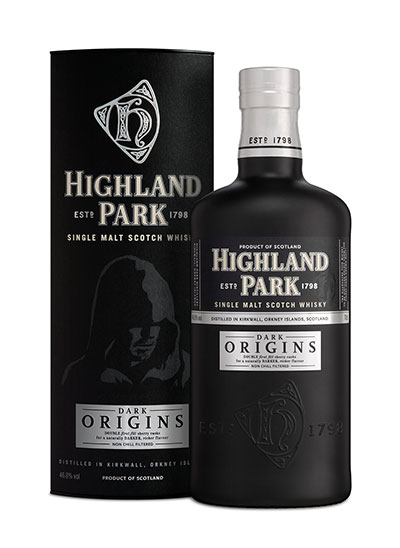
Tuesday 1st July 2014
Old Pulteney has revealed a new 35 year old limited edition release which has been matured in ex-bourbon and Spanish ex-sherry casks. Selected by distillery manager Malcolm Waring, the whisky is non-chill filtered and bottled at 42.5% ABV. This edition is limited to approximately 2700 bottles and will be available worldwide from around £500.
The accompanying packaging emphasises the maritime tradition of Old Pulteney and the distillery has certainly benefited since Jim Murray selected the 21 year old as world whisky of the year (in his opinion) in 2012. Old Pulteney Senior Brand Manager, Margaret Mary Clarke commented:
“Old Pulteney 35 Year Old is a world class expression and we are delighted to add another high age, limited edition to our existing portfolio. From its eye catching packaging to its superior taste, the new malt is a true reflection of Old Pulteney’s outstanding quality and craftsmanship. We are confident that it will take its place amongst the best luxury whiskies available today and cement our position as one of the UK’s top ten single malts.”

This release follows on from the limited 40 year old expression last year that is still widely available with retail prices ranging from £1400-£1500. As much as we enjoyed visiting the Old Pulteney distillery and experiencing its core range of whiskies, it is difficult to recommend this as an investment purchase. However it is well packaged and in the current whisky climate attractively priced for an official 35 year old release.
Saturday 28th June 2014
Bowmore 1955
A perk of being involved preparing whisky auctions is that you are able to see and examine lauded bottles that have gained mythical status amongst the whisky community. This 1955 Bowmore is a perfect example of such a bottle with a notable reputation and needless to say is rarely seen at auction.
Bowmore is a wonderful distillery to visit nowadays thanks to the opening of the visitor centre that this bottle commemorates. However it’s fair to say that in the boom current era, whisky from Bowmore has failed to live up to previous decades. Each time the subject of Bowmore comes up during a whisky tasting event, enthusiasts, will from our experience, slate the current output and wax lyrical about bottles from the 1970’s or earlier.
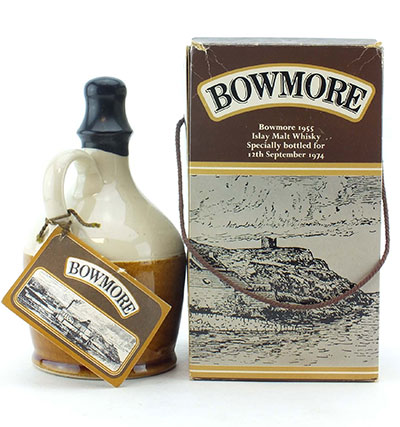 This 37.5cl bottle was distilled in 1955 and bottled in 1974 to celebrate the aforementioned visitor centre. The majority of bottles in this 100 only release fell into the hands of the distillery staff who promptly enjoyed the contents within the ceramic bottle. Unlike official limited releases today details are very scant regarding this Bowmore. For instance there is no strength or capacity stated but the quality of the whisky is widely known.
This 37.5cl bottle was distilled in 1955 and bottled in 1974 to celebrate the aforementioned visitor centre. The majority of bottles in this 100 only release fell into the hands of the distillery staff who promptly enjoyed the contents within the ceramic bottle. Unlike official limited releases today details are very scant regarding this Bowmore. For instance there is no strength or capacity stated but the quality of the whisky is widely known.
Ceramic bottles can often be the victims of a poor seal; however it is generally accepted from the surviving examples of this Bowmore that the seal on this bottle is of an extremely high and robust standard. The dinky ceramic bottle is in pristine condition along with the important seal itself. Just from holding the bottle and using our audible senses, the contents within are intact and have not been the victim of any evaporation or decay. Now if we only had the money to bid on this gem ourselves!
Aberlour A'Bunadh Silver Limited Edition
With the Aberlour A’bunadh now approaching its 50th batch release, the initial runs are growing in popularity and appreciation. These early batches are not numbered like the current editions and are only distinguished by a silver label on the bottle. It’s fair to say these are growing increasingly rare with each passing batch, but what we have here is a rather special and very illusive in terms of details and release numbers.
This silver A’bunadh is an extremely limited run of just 37 bottles with this being number 9 produced in 1999 and aged for 12 years. It is also signed by 2 individuals on the special edition label. Apart from this details are very scant about this release, with the suggestion that the 37 bottles were as a result of remnants from casks used in an early A’bunadh batch.
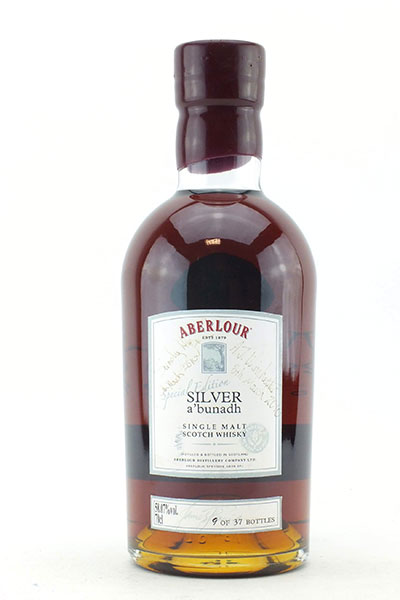
The whole existence of the A’bunadh owes itself to a bottle that was buried in the foundations of the still room at Aberlour. Distillery guides tell the story that when this still room was extended in 1973 the workmen came across this bottle wrapped in period newspaper and started to enjoy the contents of the bottle. By the time the distillery manager got wind of this discovery over half of the whisky was gone. In other words what would have been the oldest complete example of an Aberlour whisky in its original bottle had been lost. The remnants were dispatched to the company laboratory for investigation and ultimately acted as the inspiration to the A’bunadh range.
From a whisky perspective while we haven’t tasted this bottle, we have enjoyed some of the earlier releases in the A’bunadh series. These have set the benchmark extremely high, so much so that subsequent releases in the series have failed to meet expectations. This Silver A’bunadh at a strength of 58.07% should be divine.
Wednesday 4th June 2014
With a whole bunch of Feis Ile bottles arriving today we had an interesting question that deserves a post! What is Just Whisky HQ like? Here we've take a few pictures for you to see JWA in all it's glory. If you have any questions or ideas for a blog post get in touch. Maybe you'd like some extra detail on one of our auction lots?

Back of the shop with bottles ready to go!

Front office with Matteo working hard ... Ahem
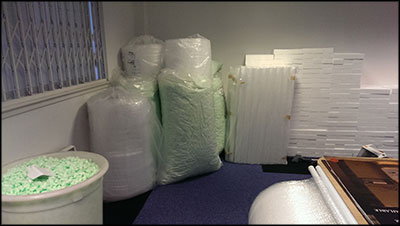
Packaging for the auction stocked up.
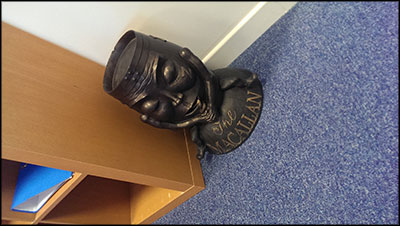
We seem to have a visitor sleeping

Our Just Whisky Clock - always on time!

Some office Decoration
We're all set for the auction to go live on Friday, so you can expect a post auction update. For those in the know, our auction previews always go live the night before. Check on Thursday night to see a preview.
---
Monday 2nd June 2014
Due to demand we have been looking into replacing PayPal as our main payment provider. PayPal offered customers ease of use, but we had some issues with expensive currency converstion rates for our overseas bidders. We were also unable to allow customers to pay without a surcharge when paying online.
Because of this, we have partnered with SagePay, one of Europe's leading payment providers. SagePay were able to help us to take payments securely online, and in a way where we are not charged nearly as much for Debit card transactions. As a result we are passing these savings onto our customers and payment by Debit card online is now completely free of charge (as it should be). An improvement which will surely be welcome. More information on SagePay can be found by clicking here.
Also you can click here for more information on ways to pay for your whisky.
If you have any questions, as always don't hesistate to drop us an email at: [email protected] or give us a call.

Saturday 31st May 2014
Nowadays it isn't too unusual to see an example from Diageo's Rare Malts Selection appearing at auction, with a variety of distilleries from its sizeable portfolio being bottled over the lifespan of the series.
The range was launched in 1995 and continued until the final selection was released in 2005. During this period, Diageo selected some of the best casks from rarely bottled distilleries such as Banff, Convalmore, Glenlochy and Glenury Royal and bottled each at cask strength, with the average run being around 5000 bottles. Diageo also took the opportunity to highlight distilleries that were predominantly components of blends including Clynelish, Mortlach and Dailuaine. The range also plays host to some of the most desirable examples of Brora and Port Ellen released to date.
This lot is slightly different, conveniently combining 5 examples in dinky 20cl bottles and was only issued in 1995 and 1996 making it incredibly rare. This item we believe is from the 1996 release and comprises of the following:
- Brora 1975 (60.75%)
- Caol Ila 1975 (61.12%)
- Dailuaine 1973 (61.80%)
- Teaninich 1972 (64.8%)
- Glendullan 1972 (62.43%)
This represents a fantastic opportunity to own this rarely seen and complete Rare Malts selection, which is in excellent condition including the original packaging.
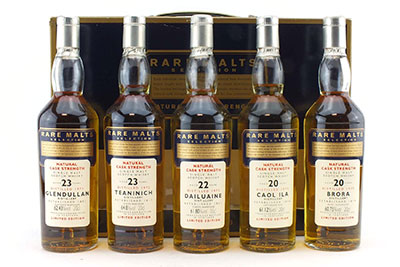
---
Monday 26th May 2014
Auctions at Just Whisky take place almost monthly but a great deal of work goes into the organising and preparing of these in Dunfermline. A regular feature we wanted to introduce is to highlight some of the forthcoming bottles in the next, or a future auction and write about what makes this bottle interesting to us.
It could well be a very exclusive release that you’ll rarely see available for auction or just something very unusual. While not everyone can see these limited editions in the flesh hopefully we can bring a little of that excitement and detail to you via this blog. Maybe there is an interesting story to the bottle from the owner? Perhaps the inspiration for the bottling or packaging is worth a little more detail than what we can accommodate in the usual auction wording? These are all things to consider when we highlight a handful of examples.
Generally the bottles will be appearing in the next auction but there could be exceptions. The reason for this is another aspect of the Just Whisky service to any potential sellers. When you approach us or drop by the office for a chat, or to hand in those bottles, we’ll take the time to highlight whether an auction already has that bottle inserted. As sellers ourselves we know from experience the disappointment when you browse an auction for the first time to realise that your Ardbeg limited edition is one of fifteen identical bottles in the sale.
Our next auction goes live on 6th of June so we have picked out a couple of interesting bottles to look at in closer detail here. First up, well it had to be a Macallan didn’t it? A genre of collecting, enjoyment and investing by itself. Those that tread into the realm of the Macallan must have deep pockets and a wealth of knowledge.
To celebrate the semiquincentenary, or 250th anniversary of Scottish literary great Robert Burns in 2009, the Macallan put together this unique package which was limited to just 250 bottles. The initial impression is created by the box of home-grown red pinewood that lacks the slickness of many Macallan boxed releases we see on the market today. Crafted by master cabinet maker, Harvey McLean, the end result is a distinctive historical casing for the lavish contents within.
No hint apart from the enamel plate is given as to the purpose of this item. Sliding off the top of the box reveals a series of contents to explore:
- A decanter made to an original design based on the head and shoulders of the Macallan bottle.
- A reproduction of a map of Burns country as it would have been in 1759.
- A unique numbered printing of your own individual Burns Poem which in this example is ‘I Gaed A Waefu Gate Yestreen’.
- 70cl of Macallan whisky matured for at least 12 years in twin casks numbered 1759
Macallan for the reproduction called upon design and illustrator David Holmes along with novelist Nicholas Salaman to provide the historical content. Their work forms part of the map outskirts putting the work of Burns into context, homespun tales of whisky form the link to the Macallan.
Sadly Macallan were unable to count upon their legendary reserves to provide a whisky from 1759 seeing how it was only granted a license in 1824. Instead there a tale regarding the 2 casks being discovered in one of the Macallan warehouses forms the connection. By some bizarre fate both of these casks had 1759 stamped upon them and it is these twin casks together that provide the whisky for this unique bottling and celebration.
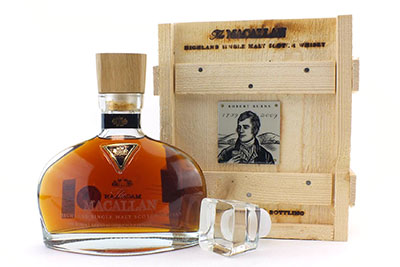
---
Monday 19th May 2014
- Technical updates to the Just Whisky site
- Improvements to the services we offer
- A look back at past bottles we’ve auctioned
- Forthcoming auction bottles and what makes these of particular interest
- A just Whisky Tasting evening in the Dunfermline area
- Just Whisky goes to a Scottish Malt Society evening
- Helpful hints to those new to whisky collecting
- Statistical information such as which distilleries are enjoying popularity or decline and bottles that are consistently performing well
- Our favourite bottles and why

